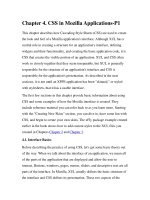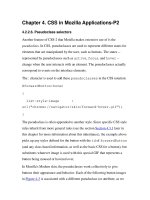Chapter 4: VTP VLAN Trunking Protocol potx
Bạn đang xem bản rút gọn của tài liệu. Xem và tải ngay bản đầy đủ của tài liệu tại đây (929.11 KB, 39 trang )
CCNA – Semester 3
Chapter 4: VTP
VLAN Trunking Protocol
CCNA Exploration 4.0
2
Objectives
• Explain the role of VTP in a converged switched network.
• Describe the operation of VTP including domains, modes,
advertisements, and pruning.
• Configure VTP on the switches in a converged network.
3
VTP Concepts
4
What is VTP?
• VTP allows a network manager to configure a switch so that
it will propagate VLAN configurations to other switches in the
network. The switch can be configured in the role of a VTP
server or a VTP client. VTP only learns about normal-range
VLANs (VLAN IDs 1 to 1005). Extended-range VLANs (IDs
greater than 1005) are not supported by VTP.
5
Benefits of VTP
6
VTP Components
• VTP Domain: Consists of one or more interconnected
switches. All switches in a domain share VLAN configuration
details using VTP advertisements. A router or Layer 3 switch
defines the boundary of each domain.
7
VTP Components
• VTP Modes: A switch can be configured in one of three
modes:
– Server
– Client
– Transparent.
8
VTP Components
• VTP Advertisements: VTP uses a hierarchy of
advertisements to distribute and synchronize VLAN
configurations across the network.
9
VTP Components
• VTP Pruning:
VTP pruning increases network available bandwidth by
restricting flooded traffic to those trunk links that the traffic
must use to reach the destination devices. Without VTP
pruning, a switch floods broadcast, multicast, and unknown
unicast traffic across all trunk links within a VTP domain
even though receiving switches might discard them.
Activity
4.1.1.5
10
VTP Operation
11
Default VTP Configuration
• VTP Versions = 1
• VTP Domain Name = null
• VTP Mode = Server
• Config Revision = 0
• VLANs = 5
12
Show vtp status command
• VTP Version: Displays the VTP version the switch is
capable of running. By default, the switch implements
version 1, but can be set to version 2.
• Configuration Revision: Current configuration revision
number on this switch. You will learn more about revisions
numbers in this chapter.
• Maximum VLANs Supported Locally: Maximum number of
VLANs supported locally.
• Number of Existing VLANs: Number of existing VLANs.
• VTP Operating Mode: Can be server, client, or transparent.
• VTP Domain Name: Name that identifies the administrative
domain for the switch.
13
Show vtp status command
• VTP Pruning Mode: Displays whether pruning is enabled or
disabled.
• VTP V2 Mode: Displays if VTP version 2 mode is enabled.
VTP version 2 is disabled by default.
• VTP Traps Generation: Displays whether VTP traps are
sent to a network management station.
• MD5 Digest: A 16-byte checksum of the VTP configuration.
• Configuration Last Modified: Date and time of the last
configuration modification. Displays the IP address of the
switch that caused the configuration change to the database.
14
VTP Domains
• VTP allows you to separate your network into smaller
management domains to help reduce VLAN management.
• It limits the extent to which configuration changes are
propagated in the network if an error occurs.
• A VTP domain consists of one switch or several
interconnected switches sharing the same VTP domain
name.
• A switch can be a member of only one VTP domain at a
time.
• Until the VTP domain name is specified you cannot create or
modify VLANs on a VTP server, and VLAN information is not
propagated over the network.
15
VTP Domains
VTP Domain Name Propagation
• For a VTP server or client switch to participate in a VTP-
enabled network, it must be a part of the same domain.
When switches are in different VTP domains, they do not
exchange VTP messages. A VTP server propagates the
VTP domain name to all switches for you. Domain name
propagation uses three VTP components: servers, clients,
and advertisements.
16
VTP Advertising
VTP Frame Structure
• VTP advertisements (or messages) distribute VTP domain
name and VLAN configuration changes to VTP-enabled
switches.
17
VTP Advertising
• VTP Frame Details
18
VTP Advertising
VTP Message Contents
• VTP frames contain the following fixed-length global domain information:
• VTP domain name
• Identity of the switch sending the message, and the time it was sent
• MD5 digest VLAN configuration, including maximum transmission unit
(MTU) size for each VLAN
• Frame format: ISL or 802.1Q
VTP frames contain the following information for each configured
VLAN:
• VLAN IDs (IEEE 802.1Q)
• VLAN name
• VLAN type
• VLAN state
• Additional VLAN configuration information specific to the VLAN type
19
VTP Advertising
VTP Revision Number
• The configuration revision number is a 32-bit number that
indicates the level of revision for a VTP frame. The default
configuration number for a switch is zero. Each time a
VLAN is added or removed, the configuration revision
number is incremented.
• The configuration revision number determines whether the
configuration information received from another VTP-
enabled switch is more recent than the version stored on
the switch.
• The revision number plays an important and complex role
in enabling VTP to distribute and synchronize VTP domain
and VLAN configuration information.
20
Summary Advertisements
• The summary advertisement contains the VTP domain name, the current
revision number, and other VTP configuration details. Summary
advertisements are sent:
– Every 5 minutes by a VTP server or client to inform neighboring VTP-
enabled switches of the current VTP configuration revision number
for its VTP domain
– Immediately after a configuration has been made
– Subset Advertisements
Subset Advertisements
• A subset advertisement contains VLAN information. Changes that trigger
the subset advertisement include:
– Creating or deleting a VLAN
– Suspending or activating a VLAN
– Changing the name of a VLAN
– Changing the MTU of a VLAN
VTP Advertisements
21
Request Advertisements
• When a request advertisement is sent to a VTP server in the
same VTP domain, the VTP server responds by sending a
summary advertisement and then a subset advertisement.
Request advertisements are sent if:
– The VTP domain name has been changed
– The switch receives a summary advertisement with a
higher configuration revision number than its own
– A subset advertisement message is missed for some
reason
– The switch has been reset
VTP Advertisements
22
VTP Advertisements Details
23
VTP Advertisements Details
24
VTP Modes
• A Cisco switch, configured with Cisco IOS software, can be
configured in either server, client, or transparent mode.
– Server Mode
– Client Mode
– Transparent Mode
VTP in action: 4.2.4.2 / 4.2.4.3
25
VTP Pruning
• VTP pruning prevents unnecessary flooding of broadcast
information from one VLAN across all trunks in a VTP
domain.
• VTP pruning permits switches to negotiate which VLANs are
assigned to ports at the other end of a trunk and, hence,
prune the VLANs that are not assigned to ports on the
remote switch.









